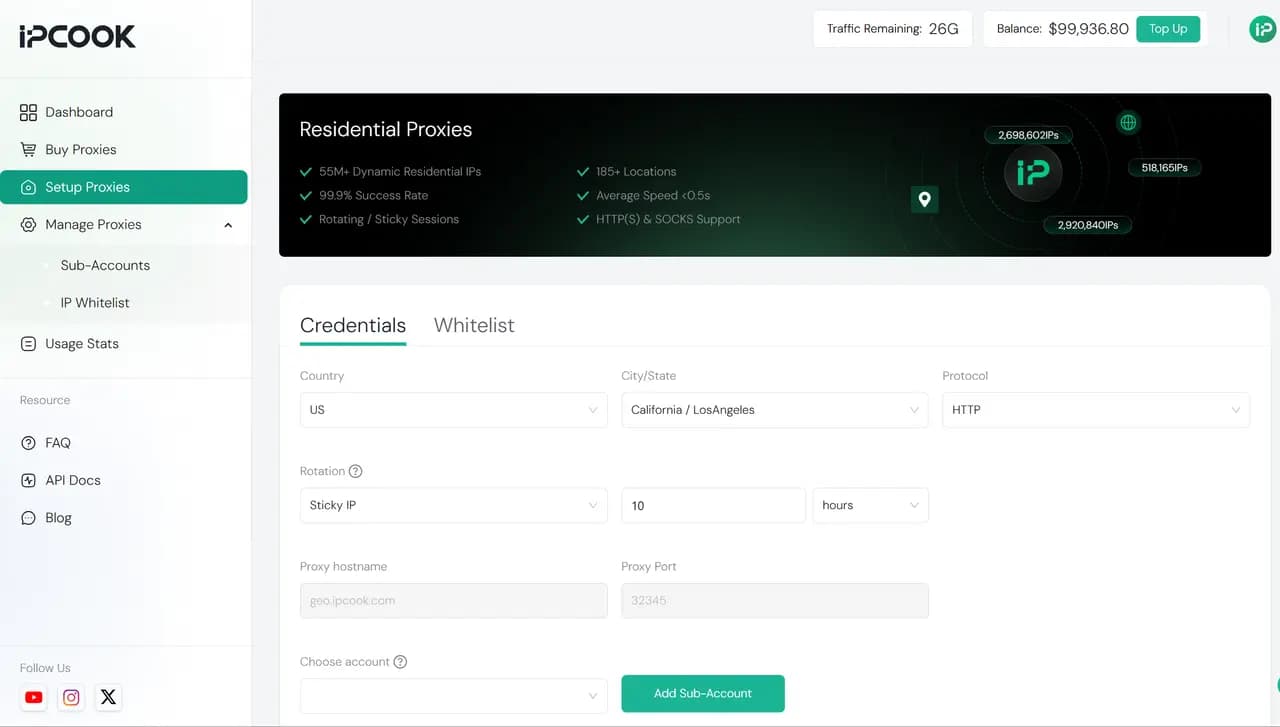How to Web Scrape a Table in Python [Complete Guide]

Learning how to web scrape a table in Python is a valuable skill for extracting structured data from websites. Tables on the web are widely used to display financial data, product prices, statistics, and more. Being able to scrape this data efficiently can support market analysis, business decisions, and research. However, scraping tables comes with challenges — some tables are static and easy to extract, while others are dynamically loaded via JavaScript, and websites often implement anti-scraping measures to block excessive requests.
This article will guide you through the fundamentals of HTML table structures and show practical Python techniques to scrape both static and dynamic tables. We'll also cover how to handle IP blocking with proxy solutions like IPcook. Whether you're a beginner or an experienced developer, you'll find useful tips and strategies to successfully extract table data from websites.
What Does It Mean to Scrape a Table from HTML?
Scraping a table from a website refers to the automated process of extracting structured data presented in tabular form on web pages. Terms like scrape table, scrape HTML table, and extract table from website all describe this action of programmatically retrieving table data without manual copying. This approach allows for efficient, repeatable, and scalable data collection.
HTML tables are built using the <table> tag, which organizes data into rows and columns. The basic structure typically includes "<thead>" for the header section, "<tbody>" for the main body, "<tr>" tags to define rows, and "<td>" tags for individual cells. Understanding this structure is essential for correctly targeting and extracting the desired data.
Unlike manually copying table content, scraping tables from HTML enables automation of data extraction tasks, saving time and reducing human errors. Common use cases include scraping financial reports, product price lists, or statistical data from websites — all examples where extracting a table from HTML provides a powerful solution to access large datasets efficiently.
How to Scrape Static HTML Tables Using Python

When dealing with static web pages, scraping HTML tables can be straightforward using Python's powerful libraries. To scrape HTML table data effectively, the typical workflow involves fetching the webpage source, parsing the HTML to locate the desired table, and then extracting the data for further use.
The first step is to use the "requests" library to download the page's HTML content. Next, "BeautifulSoup" helps parse this HTML and precisely target the "<table>" elements by traversing the DOM structure. However, for many static tables, the most efficient way is to leverage "pandas.read_html()", which can directly parse HTML tables from the raw source into Pandas DataFrames, saving significant time and effort.
Using "pandas.read_html()" is especially beneficial when the webpage contains well-formed tables, as it abstracts away complex HTML parsing and returns clean, tabular data immediately. This method suits scenarios like financial data scraping, product price monitoring, or statistical data collection, where tables are static and well-structured.
Here's a simplified example demonstrating this approach:
import requests
import pandas as pd
url = 'https://example.com/data-table-page'
response = requests.get(url)
response.raise_for_status()
# Extract all tables into a list of DataFrames
tables = pd.read_html(response.text)
# Select the first table (or the relevant one by index)
df = tables[0]
# Display the extracted table
print(df)
# Save to CSV or Excel
df.to_csv('extracted_table.csv', index=False)
# df.to_excel('extracted_table.xlsx', index=False)Commonly, the extracted table data can be saved as CSV or scraped data into Excel files for easy analysis or integration into workflows. However, when tables are loaded dynamically via JavaScript, this static scraping method may not retrieve the data correctly. The next section will explore how to handle such dynamic web tables effectively.
How to Scrape Dynamic Tables from Websites
Dynamic tables differ from static ones because their content is often generated by JavaScript after the page initially loads. This means that simply requesting the page's HTML won't reveal the full table data. Features like AJAX requests, pagination, and user-driven filters make extracting these tables more complex.
H3 Using Selenium to Extract Table Data
A common solution is to use Selenium with Python, which automates a real web browser to render the page fully. Selenium allows you to wait until the dynamic table is loaded, then locate and extract the desired data. Although this method is effective for scraping tables from websites with dynamic content, it requires more computing resources and careful handling of page loading and user interactions.
Because dynamic table scraping can be slower and more resource-intensive, especially when done frequently, it also increases the chance of your IP being blocked. In the next section, we'll explore how to overcome this challenge.
[Must Read]Overcome IP Blocking and Rate Limits with IPcook 🔥

When you frequently scrape tables from websites, sending numerous requests in a short time can easily trigger IP blocking or rate limiting. Websites often treat such behavior as suspicious, which interrupts your data extraction process and wastes precious time.
This is where residential proxy scraping becomes essential. IPcook provides a powerful, dynamic residential IP proxy service designed specifically to help scrapers evade bans and maintain smooth access. With IPcook, you get access to a large pool of residential IPs that rotate automatically, drastically reducing the risk of getting blocked. Its proxies support both HTTPS and SOCKS5 protocols, ensuring seamless compatibility with popular Python scraping tools like Requests and Selenium.
👍 Key Features of IPcook:
- Vast, real residential IP pool with dynamic rotation to avoid bans and rate limits.
- Supports HTTPS and SOCKS5 protocols, easy to integrate with Python scrapers like requests and Selenium.
- Pay-as-you-go traffic billing for flexible and cost-effective usage.
- High anonymity and stability, making your scraping appear as normal user traffic.
- Fast, reliable connections that are ideal for scraping large or dynamic tables.
IPcook is ideal for large-scale scraping tasks involving dynamic tables or websites with strong anti-bot protections. It empowers you to scrape efficiently while minimizing interruptions caused by IP bans or throttling. If you are interested in it, try IPcook to enhance your work right away!
Best Practices for Efficient Table Scraping in Python
When you scrape a table or scrape HTML table data, efficiency and stability are key. To improve your scraping process, consider these best practices:
- Set reasonable request intervals to avoid overwhelming the server and triggering blocks.
- Use a proxy pool like IPcook to distribute requests, reduce the chance of IP bans, and maintain smooth scraping.
- Precisely target the HTML table you need by carefully selecting the correct
<table>elements or CSS selectors to avoid capturing unnecessary data. - Handle pagination smartly when dealing with multi-page tables, by automating navigation or API calls to fetch all pages systematically.
- Implement robust error handling and retry mechanisms to manage timeouts, connection drops, or unexpected page changes without breaking your scraper.
By combining these best practices with IPcook residential proxies, which offer dynamic IP rotation, high anonymity, and seamless integration with Python tools, you can significantly boost your scraper's stability, avoid IP bans, and scale your table extraction tasks efficiently even against strict anti-scraping measures.
Conclusion
Scraping tables from websites effectively involves understanding the HTML table structure, choosing the right tools, and overcoming challenges like dynamic content loading and IP blocking. Python proves to be a powerful language for web scraping, especially when extracting and processing HTML table data efficiently.
To ensure smooth and uninterrupted scraping, particularly for large-scale or dynamic tables, leveraging IPcook's proxy service is essential. By combining these methods, you can confidently scrape tables from websites with high efficiency and stability. Whether you are a beginner or an experienced developer, adapting your approach with Python and IPcook will help you master how to web scrape a table in Python with ease!
